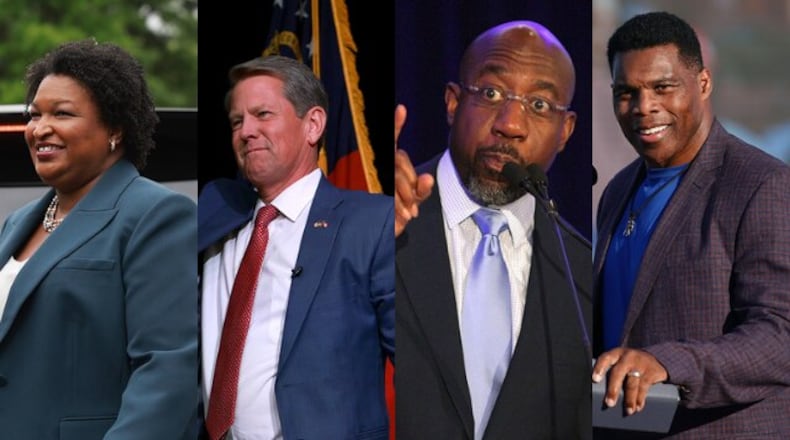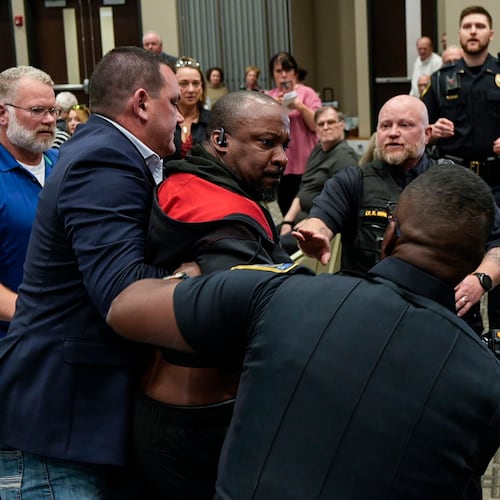Georgia’s top races have already attracted more than $360 million in spending. And TV stations are benefiting from the gusher of cash — while taking steps to rake in even more.
With Georgia emerging as the nation’s premier battleground state, local TV stations are adding more telecasts to make the most of the surge.
Channel 2 Action News added a temporary 3 p.m. newscast to accommodate more political ad spending. WAGA launched a 30-minute weekly political show and increased its coverage. Other outlets, including WXIA and Atlanta News First, have amped up their campaign coverage.
This is not a new trend. In 2017, WATL added a 7 p.m. newscast to make the most of the flood of ads during a special election in Georgia’s 6th Congressional District. And in 2020, several TV stations in Georgia made moves to soak up more campaign dollars.
But the maneuvering comes as Georgia is poised again to be at the center of the national political drama ― and ahead of a likely weekslong runoff period that could attract tens of millions of dollars more in spending.
Democratic U.S. Sen. Raphael Warnock’s campaign could once again determine control of the U.S. Senate, and this time he faces Republican Herschel Walker, who has inspired a fount of attention-grabbing news.
The rematch between Gov. Brian Kemp and Stacey Abrams pits two of the nation’s elite fundraisers against one another, and both have collected more in just the past three months than they had during their entire 2018 race. Much of it will be deployed to the airwaves.
It’s a trend that’s likely to continue into 2024 and possibly beyond.
“I don’t think anybody sees Georgia becoming less prominent on the national front in the near term,” said Scott Stucky, WAGA’s news director.
The outlet’s 30-minute “Road to November” show is syndicated on stations in Augusta and Savannah, station manager Bill Schneider said. And it has added staffers to catch candidates far beyond Atlanta.
“If the candidates were in Macon or Augusta, we traditionally wouldn’t be represented,” Stucky said. “But we see all the time that big news can pop up any time at any place with the candidates.”
Channel 2 is expanding its coverage, too, dispatching crews across the state and the region to cover the big moments in the campaign. Ray Carter, the station’s general manager, said the increased attention is a taste of what’s to come with a presidential election looming in two years.
“There’s no question that Georgia has moved from a solid red state to somewhat purple.” Carter said. “That affects how we view politics and campaign coverage.
“When we look at ‘24 with a presidential race and all eyes on Georgia, I expect us to add to our impressive array of resources to cover it like no other electronic media outlet.”
Tidal wave
It’s part of a tide of local TV spending in battleground states such as Georgia.
The AdImpact tracker service estimates that broadcasts could take in nearly $5 billion this midterm campaign cycle nationwide, and Georgia is one of the biggest beneficiaries — or victims, depending on your view — of the crush of spending.
Already, more than $235 million on advertising has been spent or reserved in the race for the U.S. Senate, media strategist Rick Dent said. Democrats have an edge, with more than $128 million backing Warnock, compared with $107 million devoted to Walker.
In the race for governor, more than $58 million has been devoted to TV ads boosting Abrams while about $39 million supports Kemp. That’s more than either candidate raised during the 2018 campaign.
“We literally have fundraisers just about close to 6 1/2 days a week on average, all the way through the election,” Kemp said. “And we just have to have that funding to be able to operate everything we need to do to make sure that we win.”
Dent said the state’s closely divided politics ensures that Georgia “will be the center of the political universe for control of the U.S. Senate for the foreseeable future.”
“And that means hundreds of millions of out-of-state special-interest dollars will continue to flood into Georgia,” he added, “money fueling negative ads that care nothing about the people of Georgia and everything about people running Washington.”
‘Easter stroll’
Many voters share Dent’s concern over the newfound attention ― and exhaustion with the back-to-back-to-back ads.
Molly Howes, a 24-year-old waitress who moved to Roswell last year, said she’s used to being bombarded with information about candidates. She grew up in Iowa, where ads were particularly common ahead of the state’s presidential caucuses every four years.
But this election cycle, she said, has been the worst she’s seen. Howes said she’s often seen the same ads while watching Hulu several times throughout a single episode, largely on behalf of Democrats.
“It’s already so obvious in my head which ones I’m going for … so it’s been pretty frustrating because I feel like I definitely know the information,” Howes said. “Every election cycle, everyone focuses more on attacks and less on information, so nobody knows who they’re voting for. It’s just the lesser of two evils.”
Anna Kottakis, a senior at Emory University, echoed many by relaying her frustration over one ad that refers to Walker’s threats of violence against his ex-wife and other women.
“Not that it’s not important information for voters to know,” Kottakis said. “But it got to a point where (the ad) would come on and I would be like, ‘This is upsetting, I’m not paying attention to this.’ ”
The spigot shows no sign of slowing, particularly if any of Georgia’s top races lands in a December runoff. That happens if no candidate emerges with a majority of the vote.
Mike Murphy, a veteran Republican operative, quipped that a runoff in the Senate contest would make the last few months of ads seem like an “Easter stroll.”
“Both parties are going to come rolling in there with clubs and dollars,” he said. “The state is going to be melted.”
Staff writer Anjali Huynh contributed to this article.
About the Author
Keep Reading
The Latest
Featured




